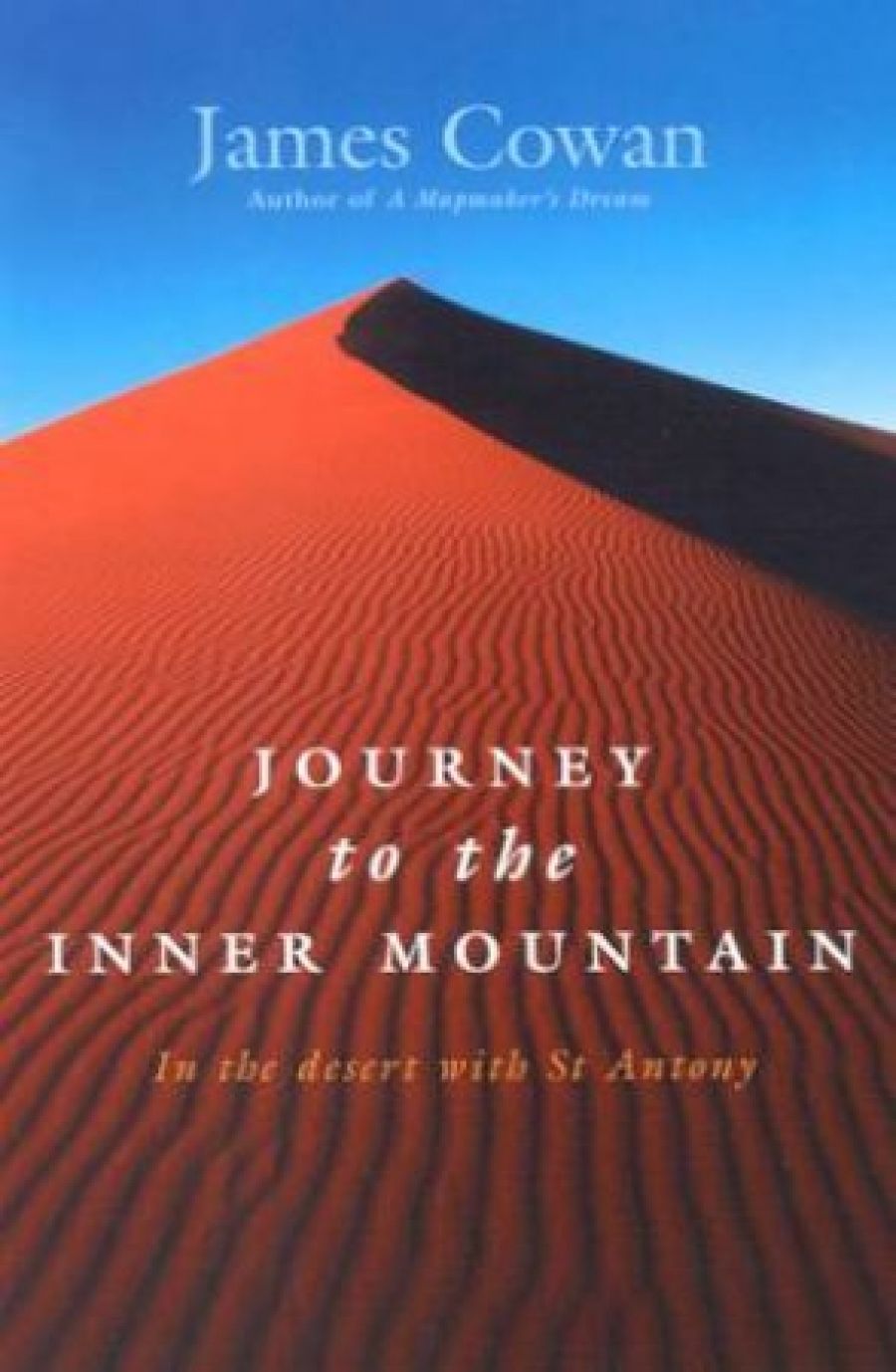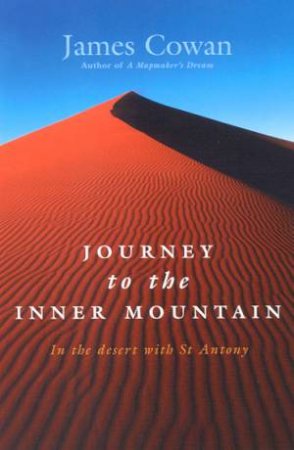
- Free Article: No
- Contents Category: Religion
- Review Article: Yes
- Article Title: Long Night’s Journey
- Online Only: No
- Custom Highlight Text:
James Cowan has a gift for writing about shadowy figures. His previous book, Francis: A Saint’s Way (which I reviewed in ABR, August 2001), probed the many myths that have gathered over the centuries around the figure of Francis of Assisi. It returned to the relatively small number of facts that are known about Francis, and worked with them to distil something of the essence of a character who has had a profound influence not just on the Christian tradition, but well beyond. It also revisited the places where Francis lived to ask questions about the relationship between environment and character, especially spiritual character.
- Book 1 Title: Journey to the Inner Mountain
- Book 1 Subtitle: In the Desert with St Antony
- Book 1 Biblio: Hodder & Stoughton, $29.95 hb, 207 pp
- Book 1 Cover Small (400 x 600):

- Book 1 Cover (800 x 1200):

In many ways, Cowan’s new book, Journey to the Inner Mountain, is a companion volume to Francis. If anything, it is in search of an even more slippery character than Francis. St Antony of Egypt (251–356) was the child of Christian farmers, but was orphaned as he approached adulthood. Taking on board the injunction of Christ to ‘sell what you possess and give to the poor’, Antony entrusted his sister to the care of chaste women and began moving around, looking for holy men to advise him. He had given up the power that came with being a landowner. He wove baskets to support himself. Once people started to approach him for advice, he relinquished the power that came with being an oracle and settled in a hut on the edge of a village. This was where he experienced the various temptations and hallucinations that have fascinated creative people, artists and writers, including Gustave Flaubert.
Giving up the power that might come with some kind of spiritual victory, Antony moved into a tomb where he lived for years as one of the living dead. He then went further afield and found a cave in the desert. All this time, he was sanding away every aspect of human ego that might enjoy any sense of achievement or influence. Cowan calls him a ‘minimalist’, which is an understatement. The irony of Antony’s life, however, is one that is familiar to just about every spiritual tradition. He worked hard at holding onto powerlessness. The result is that he has become a powerful figure for the religious imagination. He was the original anchorite, a word that comes from the Greek for withdrawal in the sense, as Cowan explains, of social disengagement. This is not the St Antony who helps you find things. This is the one who helps you to lose them. ‘In a full stomach,’ wrote Antony, ‘there is no knowledge of the mysteries of God.’
Cowan explains that his interest in Antony began years ago when he found the image of a man who ‘defied logic’: ‘He proposed dirt, hunger, loneliness, demonic battle, anti-sociability, non-ambition, non-material aspiration, a-sexuality and the denial of all family affections as the basis of a new kind of adventure. It was almost as if he wished to deny everything that made the human experiment worthwhile.’ In 1999 Cowan had an opportunity to visit Egypt and trek to the mountain and cave that Antony made famous. Here he encountered a fellow Australian who had taken the name Lazarus. ‘Because I am reborn,’ the man explained portentously. Once upon a time, Lazarus had been a confused man wandering the streets of Melbourne. He found his way into a church where he experienced something like a call to relinquish any pretence of control over his own life. Now he was living in solitude in the Egyptian desert, emulating the bare-bones existence that Antony pioneered. Lazarus becomes Cowan’s guide and, consequently, the living centre of the book. This figure embodies difficult answers to some of Cowan’s most heartfelt questions, especially regarding the possibility of disengagement from a material world that is even more seductive and spellbinding than the one Antony forgot.
There are extraordinary riches in Journey to the Inner Mountain. Cowan draws the reader into the world not just of Antony but of anchorites who followed him for several hundred years after his death. Through them, he provides access to a treasure chest of spiritual writing that is all but dormant, even within theological circles. Cowan is also honest in pondering the implications of such experience for contemporary living. It’s a pity that his prose style is often laboured and ornate, working so hard that it sometimes obscures the very things it tries to illuminate. Antony is the minimalist, not Cowan.
Nevertheless, it is in a context of appreciation that I mention some reservations about the substance of Journey to the Inner Mountain. The first is that Cowan tends to create a needless dichotomy between profound spiritual experience, which tends towards wordlessness, and the life of the rational mind. He says, for example, that the anchorites ‘often regarded doctrinal orthodoxy as an impediment in their lifelong pursuit of apatheia’. Apatheia does not imply apathy but a release from anxiety and freedom from governing passions.
It is almost as if Cowan overlooks the areas in his own research that point to a reconciliation between the rational and spiritual. Indeed, one of the most significant figures in this book is St Athanasius, who wrote the first biography of Antony. Without Athanasius’s words, Antony would have been lost. This is the same Athanasius who was a leader in fourth-century Christian debate. He devoted a large part of his life to finding the right words with which, in some sense, to define Christ’s relationship to God. He was the man who occasioned the phrase ‘an iota of difference’, not because he was inclined to split hairs, but because he understood the power of the wrong idea. At the same time, Athanasius had an obvious regard for the mysticism of Antony.
Cowan is also keen to liberate Antony from his ecclesial context. He attempted to do the same with Francis. In both cases, this leads to some valuable links across communities that can stifle themselves by being isolated from each other. In Francis’s case, Cowan made fascinating links to Islam. In Antony’s case, he builds bridges in many directions, to Zen and even to the Marquis de Sade. But he tends to downplay the manner in which those who isolate themselves from a community continue to address that community and even reveal aspects of the community to itself. Antony has never been a popular saint for Christians in the way St Antony of Padua has been. He is too scary. He doesn’t help you find a place to park the car. But for every individual who follows the call to solitude, there are tens of thousands who flirt briefly with the idea and wonder ‘what if’. Over the centuries, most of those who have used Antony as the starting point for such fantasies have been members of Christian communities. His real power has been in the impact he has had on such lives. He has enabled people, perhaps just for a few minutes, to laugh at their own anxieties and their own will to power.


Comments powered by CComment